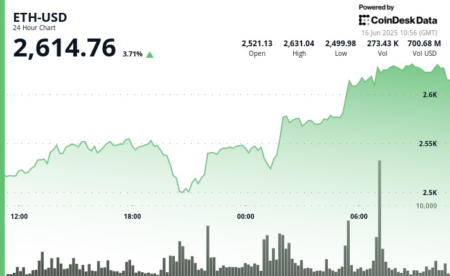Ether (ETH) has underperformed other cryptocurrencies in recent months as the Ethereum blockchain has faced “intense” competition from other networks, Wall Street bank JPMorgan (JPM) said in a research report on Wednesday.
The token lacks a compelling narrative like that of its larger peer bitcoin (BTC, the bank said, adding that bitcoin benefits from its perception as a store of value and as digital gold.
Despite upgrades, such as Dencun, activity has shifted from the main Ethereum network to its layer 2’s, which is detrimental to the blockchain’s growth, the report said. The network’s latest upgrade, Pectra, is likely to happen in early April.
“Competitive pressures have led some decentralized applications (dapps) to migrate from Ethereum to other application-specific chains for better performance,” analysts led by Nikolaos Panigirtzoglou wrote.
Examples include decentralized exchanges (DEXs) such as Uniswap, dYdX and Hyperliquid, the bank said.
Uniswap’s upcoming move to Unichain is important because it is one of Ethereum’s “largest gas consuming protocols,” and its migration could result in a significant loss to the network’s fee pool, the bank noted.
JPMorgan said this trend of dapps moving to other layer 2s or alternative layer 1s could negatively impact Ethereum by lessening activity on the main network, which could result in lower transaction fees and validator revenue.
Layers 2s are separate blockchains built on top of layer 1s, or the base layer, that reduce bottlenecks with scaling and data. In terms of supply, this could make ether inflationary as “fewer transactions imply reduced token burning,” the authors wrote.
The bank noted that Ethereum’s growth is behind that of competitors such as Solana, which saw a surge in activity linked to memecoins.
The Ethereum ecosystem still dominates the stablecoin, decentralized finance (DeFi) and tokenization spaces in spite of these challenges, the bank said.
The network could see increased institutional demand from tokenization enterprises but “competition from other networks is likely to remain intense in the foreseeable future,” the report added.
Read more: How to Fix Ethereum’s Fragmentation Problem
Read the full article here









